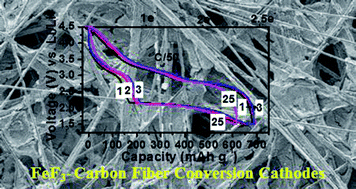Electrode architectures for high capacity multivalent conversion compounds: iron (ii and iii) fluoride†
Abstract
We report novel electrode architectures for high capacity multivalent conversion compounds such as iron (II and III) fluoride. The material and electrode design approach addresses the intrinsically poor transport and diffusion kinetics associated with ionic solids such as iron fluorides and significantly improves their electrochemical and cycle life performance. A comparison is made between the performances of 3D electrode architecture versus the slurry coated fluoride electrodes. Detailed microstructural analysis and mechanistic scenarios are discussed that would enable development of practical high energy density conversion based electrodes for energy storage application.

- This article is part of the themed collection: Nanoscience and nanotechnology in electrochemistry

 Please wait while we load your content...
Please wait while we load your content...